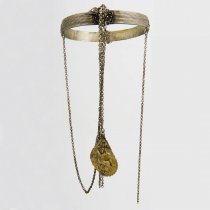"He (the Lord) keeps all their bones …" (Psalm 33: 21)
Reliquary.
1802.
BXM 2207
Silver reliquary casket with vegetal decoration in relief. The lid bears a representation of Hagioi Theodoroi and an inscription that reads: “ ΘΕΟΚΛΗΤΟΥ ΙΕΡΟΜΟΝΑΧΟΥ•ΔΗΜΗΤΡΙΟΥ ΚΑΙ ΤΩΝ ΓΟΝΕΩΝ ΑΩΒ”. It comes from Adrianople, possibly from the church of Hagioi Theodoroi in the suburb Karaağaç (Orestias), where the city’s railway station was situated. The reliquary conforms to the commonest box-shaped type, possibly produced by local workshops for which we lack further information, although references by Evliya Çelebi and other travellers of the 17th century are available.
Adrianople, the largest centre of byzantine Thrace, became the Ottoman capital for the period between its conquest (1369) and the Fall of Constantinople (where the capital was transferred in 1455). Throughout the Ottoman rule, the city was episcopal see and evolved into a major cultural, financial and commercial centre due to its location along the routes that connected Western Europe with the Near and the Far East (India, China). A total of 26 churches have been reported in the city and its suburbs, of which 5 were destroyed in the conflagrations of 1905 and 1914. These churches included, among others, the Metropolis, dedicated to the Dormition of the Virgin, Panagia Kolykaraia (church of the Nativity) where lay a healing chamber for the mentally ill, Saint Paraskevi (metochion of the Holy Sepulchre) and Saint Nicholas, where a mutual instruction school operated. Until the Population Exchange, only four churches were used: the Metropolis, the church of Saint John the Theologian (metochion of Saint Catherine’s Monastery on Mount Sinai), Saint Stephen and the Taxiarches.
Five (5) more objects kept at the BCM arrived from churches of Adrianople through the Exchanged Populations Fund.



.jpg)
.jpg)
.jpg)
.jpg)
.jpg)
.jpg)
 Purple Gospel
Purple Gospel .jpg) The double-sided icon from Tuzla
The double-sided icon from Tuzla .jpg) An emblematic refugee “relic”
An emblematic refugee “relic”  A byzantine Hodegetria
A byzantine Hodegetria  An Evangelistary from Trebizond
An Evangelistary from Trebizond .jpg) A significant Palaeologan work
A significant Palaeologan work  Tetraevangelion from Adrianople
Tetraevangelion from Adrianople .jpg) A Cretan icon from Eastern Thrace
A Cretan icon from Eastern Thrace .jpg) “Joined in matrimony”
“Joined in matrimony”  A peculiar neckband
A peculiar neckband  Fragmented memory
Fragmented memory .jpg) Zumzud, the pilgrim
Zumzud, the pilgrim .jpg) A refugee heirloom in “Russian style”
A refugee heirloom in “Russian style” .jpg) An unusual “icon” from Cappadocia
An unusual “icon” from Cappadocia .jpg) "He (the Lord) keeps all their bones …" (Psalm 33: 21)
"He (the Lord) keeps all their bones …" (Psalm 33: 21) .jpg) A Karamanli icon
A Karamanli icon 



